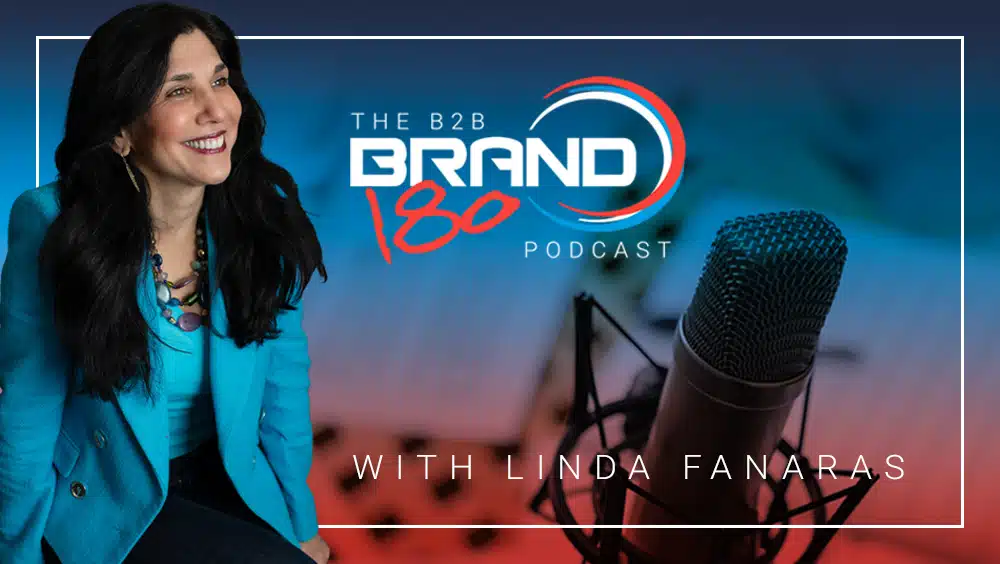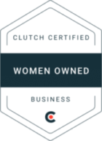In this episode of the B2B Brand180 Podcast, Linda Fanaras speaks with Dr. James Richardson, a seasoned entrepreneur and founder of Premium Growth Solutions, about expert strategies for CPG entrepreneurs looking to transform their ideas into premium brands.
With a focus on the consumer-packaged goods industry, Dr. Richardson shares valuable insights and actionable tips on product development, branding, and marketing.
You can learn more about Dr. Richardson and his work at https://www.premiumgrowthsolutions.com.
Linda Fanaras:
Hi, I am Linda Fanaras, host of B2B Brand 180 and CEO of Millennium Agency. If you want to transform your B2B marketing into a powerhouse brand, then you may want to listen in. And if you like what you heard today, click like, share or subscribe. There’s no doubt that CPG marketing continues to grow, and e-commerce has really taken on a life of its own. Dr. James Richardson, PhD launched a book called “Ramping Your Brand: How to Ride the Killer CPG Growth Curve,” and it has received phenomenal reviews. So, in his book, Dr. Richardson outlined a four-part approach to thinking smarter about growth as a CPG entrepreneur. And during his time, he conducted years of research into how and why consumers pay for premium price CPG items and the intensive four P pattern analysis among top CPG brands that all reached a hundred million plus in less than 10 years. And that’s why I brought in Dr. James Richardson today from PGS Cultural Anthropologist Strategy Consultant and CPG expert so welcome James to the B2B Brand 180 podcast. Thanks for joining me today.
James Richardson:
Thanks for having me, Linda. Well, you did a great intro, so I won’t try to add too much more. I call myself an anthropologist term business strategist because that’s, I think, what everyone can understand the best. But what I really do is management consulting for founders who are new to the industry.
Linda Fanaras:
That’s great. So, I’m excited to talk today really about how to bridge that gap between CPG strategies and increased sales. CPG is a hot market, so I think let’s get started. I know that what we do know, one thing, James, is that if you want to command a premium brand, you just can’t have a great idea, but rather an amazing brand, brand positioning and strategy. So how do these CPG companies go to market and command a premium?
James Richardson:
I think that overall, I can say that they do it by becoming an expert in their category and, on occasion that’s accidental, to be honest. They’re often geeks, who are super disappointed with something, with some category out there in the grocery store. And this can turn into a personal obsession, which then turns into a business. Most people in the world that I’m in are amateurs, essentially, with an expert understanding of a category’s deficiencies. And you know, I think those of you who are B2B marketers and work with clients who are in, who are selling, you know, not fast-moving consumer goods, you’re used to your clients being pretty sophisticated about their categories, right? And that, that is taken for granted, I think, by a lot of B2B marketers. But in my world, it’s insanely competitive. And so, you really do have to you have to tap into something behavioral.
Linda Fanaras:
And that’s interesting that you speak about that because I think the behavioral part of CPG products or companies that develop products have to determine what the behavioral aspects are, and also have to message emotionally around that behavior in order to get them connected to the brand.
James Richardson:
There’s a lot more emphasis on what is the emotional consequence of consuming the product that I can then exaggerate in marketing. Dr. Squatch soap, one of my former clients is a great example of that hyperbole, right? They created a three-minute anchor video on YouTube that has now over a billion views in three years and created a half billion dollar business in two years because they used emotion to tap into an audience that had never been addressed in personal care.
Linda Fanaras:
Mm-hmm. And that’s a fascinating case study that you presented there. And I do think that’s where a lot of CPG companies do go wrong. They get focused on the features and, you know, you may talk about the benefits, but no, it’s really more than that. It’s more about the emotional aspect that ties them – the one key item that they can hang their hat on and say, okay, what is it about that product that really makes me want it and makes – it will make me feel good-
James Richardson:
Yeah, and I think that the challenge is that – the challenge I’ve always seen is that – because that’s often taught, that’s like taught at Kellogg, right? People get MBAs in Consumer Marketing. They all go into the CPG universe. They’re taught to wind up with an emotional sort of positioning, and I think that’s great for advertising. But that won’t, that won’t actually create a premium brand, by itself. You have to design an actual thing whose consumption experience is elevated and modern. And if you can’t, you know, so you can’t just do this with a new flavor of Ritz cracker. So, the problem that I’ve seen is that the emotion has to come out, to come from an innovative consumer experience that the consumer is now consciously aware of as they’re consuming it. And it’s also emotional, but it’s emotional from the product innovation, not the arrogance of an established brand. So, so that’s a lesson even for folks who are working with, like, established durable goods companies and you’re the marketing agency, it’s still a lesson you can apply to an incumbent brand because if you want to actually do something innovative, you actually have to engage in something they call creative destruction, you have to be willing to attack your own business. And you should do that under another trademark. But – that goes without saying – but very few consumer goods companies want to actually do that. They’re more likely, I found, more likely to acquire my clients after they scale than to, than politically inside those companies to come up with: “Well, Ritz is gonna, Ritz isn’t growing anymore, so we need a new cracker. Let’s just create a new brand.” They almost never do that.
Linda Fanaras:
Yeah, and I think with some of these CPG firms and companies, it’s, you know, it’s challenging to start, to be a startup and to define a space in the market that they can take advantage of and then potentially, or eventually compete with some of the larger brands. And that takes time and obviously, and money. But it is that strategy to be able to innovate a brand or a product that is different and that makes it unique and allows them to, you know, use them to leverage and grow their brand.
James Richardson:
I think you’re right. I think that the challenge is what do you do with traditional principles of branding? And I think that, what I’ve noticed is that the branding can be really powerful in making you appear essentially bigger than you are. And more professional and cool than you are. But in my world, the growth is mostly product experience driven. So, the brand actually has to honor that. But if you’re not innovating, I don’t know. I haven’t seen a lot of companies that get to the actual scale in my industry, just off a branding layer and no product innovation. Usually if they did, it’s because they had a great sales team.
Linda Fanaras:
So, I did notice in your book you had mentioned something you said, “Don’t hit the gas too early. Successful CPG startups manager rolling iterative experiment until key KPIs appear, you should learn this art.” So, what do you mean by that? Can you speak to that a little bit?
James Richardson:
So, the crash rate is a little higher in CPG than in durable goods. And the crash can happen real fast, like within six to nine months if you go out too fast with the wrong thing because they didn’t take the time to study their fans-
Linda Fanaras:
Right, exactly.
James Richardson:
-to learn what were, what are the aspects of the consumer experience and the design that are really driving repeat purchase and fandom, I mean, it’s often not what caused the founder to create the product. This is a real problem with amateurs, is their non-objective approach to innovation. It’s literally subjective. It’s literally birthing it from their heart into the universe as a critique of the category. But their critique is often off centered from what’s going to generate the growth. So, most of what I do is get people to realize, to reframe what they have. I come in and say, “No, that’s not actually your edge. Your edge is this.” I often have to come in and sort of help people better understand the thing that they have so that they can get it on a growth. The one thing that’s in my book that I’ve learned at least, is that usually it’s about a mass market outcome. From the user experience, that’s what unlocks the growth and that’s what gets them the correct positioning. Dr. Squatch is a great example. They started marketing as just another over pressed soap bar. They marketed as a natural, non-processed soap bar. Well, that had been tried for 40 years, but that didn’t create any business for anybody. There’s probably 20 brands doing that. Because the minute you put it in that box, there’s just this tiny audience that even wants to listen to you. But once you reframe it as: “We’re gonna modernize your masculinity in the shower,” now you have a huge audience.
Linda Fanaras:
Right. You’re connecting, you’re making a connection.
James Richardson:
So it’s the same product, same formulation, same attributes. You’re just connecting them to a different outcome through great storytelling.
Linda Fanaras:
Great point. Companies, you know, we know they love to be everything to everyone, and steady velocity growth is essential to ramping up anybody’s brand. But what I’m curious about is how do these CPG teams actually learn how to sustain that in key geographies, key demographics, so they don’t have to buy like premature distribution to obtain some growth with their sales.
James Richardson:
So, there’s a bunch of different ways to do it, and I think that the presumption here is that you’re not going to start off with a mature marketing budget. And that’s actually true with big companies too. They’re not going to assign $30 million advertising campaign to a new launch. That almost never happens unless the CEO came up with the idea. So, what people do is a combination of cheap tactics, which take more time. They take years to have an effect, and they precede the market. So, they’re actually building awareness nationally through PR, free, like appearances in targeted media, right? And even in events. And they’re using out of store event sampling, and then marketing to also build awareness. That’s when they get in the market. So, it’s – what I tell my clients is that when your tool is appearances in the media that are earned (so free) your team just pitched people and you go, when that’s your tool you have nothing to lose doing that years ahead of becoming a national distributor. Nothing to lose, as long as you can maintain it. Because what happens if you have an interesting product, it’s design will cause intrigue with the right people. Some of them want to buy right away and go to your website and pay the extra shipping. And so, then you start building, these geeks will start appearing in major cities, which is great because you can activate those people later. When I work with my clients, I tell them to use cheap techniques to build the awareness before you show up in stores. That includes using online sales. Online sales if you can afford them. Because it’s better to be – the way that you become a cool premium brand in almost any category is that people have heard about you for a while. And you’re exclusive and they can’t get in touch with you. They can’t get a hold of you. That’s what causes brands to have a premium halo.
Linda Fanaras:
So James, what I’d like to do now, just to wrap it up, is could you give me your perspective and provide maybe three key takeaways for an innovative CPG brand that you think that you could help our audience with?
James Richardson:
Yeah, I, the first is design a modern innovation in a category that you know really well and are passionate about and get it into the market. Then let it soak. Talk to your fans who are repeat purchasers and learn what are the outcomes in their life that, that your product is fulfilling really, really well? What makes it cool to them and how do they feel about it? That gives you the material to develop the kind of messaging you want on your package you want to hand your branding agency and your marketing team. And then three is don’t add distribution until you’ve figured out your out-of-store and in-store marketing playbook that is creating irrationally high velocities for a small business. And that’s all going to be benchmarked to your specific category. But when you’re selling 2, 3, 4, 5 times as fast as the startup next to you, that’s how distribution will come to you. In a natural way that’s a lot more effective.
Linda Fanaras:
Well, that’s great. So again, thank you today for listening in and on behalf of B2B Brand 180, thank you James. And just to recap, he works with CPG companies who are experiencing growth and want to continue that growth, and maybe they want to get their brand on the ramp to success. So just check out his book. Here’s a great quote that I want to share: “This book illuminates both the strategy and the tactics that can put a CPG entrepreneur on the path to success.” To get in touch with James, visit www.premiumgrowthsolutions.com or visit rampingyourbrand.com to buy his book, which is available on Amazon. I’m Linda Fanaras, host of B2B Brand 180 and CEO of Millennium Agency, which if you’d like to visit us, visit mill.agency, or connect with me on LinkedIn. And to help our channel grow and educate more B2B leaders on brand strategy, feel free to click, like, share, or subscribe. Thanks again.





























